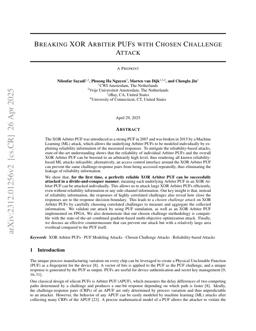2025-04-26
Breaking XOR arbiter PUFs with chosen challenge attack
Publication
Publication
The XOR Arbiter PUF was introduced as a strong PUF in 2007 and was broken in 2015 by a Machine Learning (ML) attack, which allows the underlying Arbiter PUFs to be modeled individually by exploiting reliability information of the measured responses. To mitigate the reliability-based attacks, state-of-the-art understanding shows that the reliability of individual Arbiter PUFs and the overall XOR Arbiter PUF can be boosted to an arbitrarily high level, thus rendering all known reliability-based ML attacks infeasible; alternatively, an access control interface around the XOR Arbiter PUF can prevent the same challenge-response pairs from being accessed repeatedly, thus eliminating the leakage of reliability information. We show that, for the first time, a perfectly reliable XOR Arbiter PUF can be successfully attacked in a divide-and-conquer manner, meaning each underlying Arbiter PUF in an XOR Arbiter PUF can be attacked individually. This allows us to attack large XOR Arbiter PUFs efficiently, even without reliability information or any side-channel information. Our key insight is that, instead of reliability information, the responses of highly correlated challenges also reveal how close the responses are to the response decision boundary. This leads to a chosen challenge attack on XOR Arbiter PUFs by carefully choosing correlated challenges to measure and aggregate the collected information. We validate our attack by using PUF simulation, as well as an XOR Arbiter PUF implemented on FPGA. We also demonstrate that our chosen challenge methodology is compatible with the state-of-the-art combined gradient-based multi-objective optimization attack. Finally, we discuss an effective countermeasure that can prevent our attack but with a relatively large area overhead compared to the PUF itself.
| Additional Metadata | |
|---|---|
| , , , | |
| Organisation | Computer Security |
|
Sayadi, N., Nguyen, P. H., van Dijk, M., & Jin, C. (2025). Breaking XOR arbiter PUFs with chosen challenge attack. |
|


